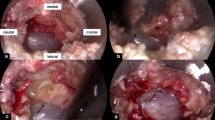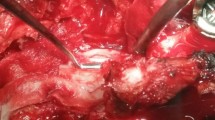Abstract
Objective
The efficacy and safety of povidone–iodine in wound dressing and irrigation of some operative cavities were established by many in vitro and in vivo experimental reports and clinical series. However, its use in defective tissue in neural structures has not been confirmed yet. The aim of the present study was to histopathologically investigate its effect on neural tissues when applied on the upper side of defective dura.
Methods
Wistar rats were randomly divided into two experimental groups: control and povidone–iodine groups. In the control group, durotomy was performed following laminectomy, and the spinal cord was covered with a dry sponge. In the study group, the same procedure was performed, but open duras were covered with a sponge that had been wetted with 0.1 % povidone–iodine solution. Three weeks after surgery, all experimental animals were sacrificed, and histopathological evaluations were conducted.
Results
Myelin changes were absent or minimal in all cases of the control group but were present as markedly increased myelin degeneration in nearly all cases in the study group. Axonal degeneration and hypoxic neuronal damage were absent in the control group, whereas they were marked in half of the study group. No statistically significant differences were established in Schwann cell proliferation, venous congestion, and lymphocytic proliferation between the two groups.
Conclusions
Based on the present study, 0.1 % povidone–iodine solution cannot be recommended for wound dressing for neural structures such as myelomeningocele cases because of possible damage to underlying neural tissues.






Similar content being viewed by others
References
Van Den Broek PJ, Buys LMF, Van Furth R (1982) Interaction of povidone–iodine compounds, phagocytic cells, and microorganisms. Antimicrob Agents Chnnother 22:593–597
Burks IR (1998) Povidone–iodine solution in wound treatment. Phys Ther 78:212–218
Chang FY, Chang MC, Wang ST, Yu WK, Liu CL, Chen TH (2006) Can povidoneiodine solution be used safely in a spinal surgery? Eur Spine J 15(6 Suppl):1005–14
Kloth LC, McCulloch JM (1995) The inflammatory response to wounding. In: McCulloch JM, Kloth LC, Feedar JA (eds) Wound healing: alternatives in management. FA Davis Co, Philadelphia, pp 1–15
Daly TJ (1995) Contraction and re-epithelialization. In: McCulloch JM, Kloth LC, Feedar JA (eds) Wound healing: alternatives in management. FA Davis Co, Philadelphia, pp 32–46
Tatnall EM, Leigh IM, Gibson JR (1987) Comparative toxicity of antimicrobial agents on transformed keratinocytes. J Invest Dematol 89:316–317
Branemark PI, Albrektsson B, Lindstrom J, Lundborg G (1966) Local tissue effects of wound disinfectants. Acta Chir Scand 357:166–176
Roberts AH, Rober’ FE, Hall RI, Thomas IH (1985) A prospective trial of prophylactic povidone iodine in lacerations of the hand. J Hand Surg 10(3 Suppl):370–374
Gravett A, Sterner S, Clinton JE, Ruiz E (1987) A trial of povidone iodine in the prevention of infection in sutured lacerations. Ann Emerg Med 16(2 Suppl):167–171
Goldenheim PD (1993) An appraisal of povidone iodine and wound healing. Postgrad Med 69(3 Suppl):97–105
McLagarde JSB, Cohn I Jr (1978) Intraperitoneal povidone–iodine in experimental peritonitis. Ann Surg 6:613–618
Chundalama J, Wright JG (2007) The efficacy and risks of using povidone–iodine irrigation to prevent surgical site infection: an evidence-based review. Can J Surg 50(6 Suppl):473–481
Doan L, Piskoun B, Rosenberg AD, Blanck TJ, Phillips MS, Xu F (2012) In vitro antiseptic effects on viability of neuronal and Schwann cells. Reg Anesth Pain Med 37:131–138
Author information
Authors and Affiliations
Corresponding author
Rights and permissions
About this article
Cite this article
Akcay, E., Ersahin, Y., Ozer, F. et al. Neurotoxic effect of povidone–iodine on the rat spine using a laminectomy–durotomy model. Childs Nerv Syst 28, 2071–2075 (2012). https://doi.org/10.1007/s00381-012-1885-7
Received:
Accepted:
Published:
Issue Date:
DOI: https://doi.org/10.1007/s00381-012-1885-7




